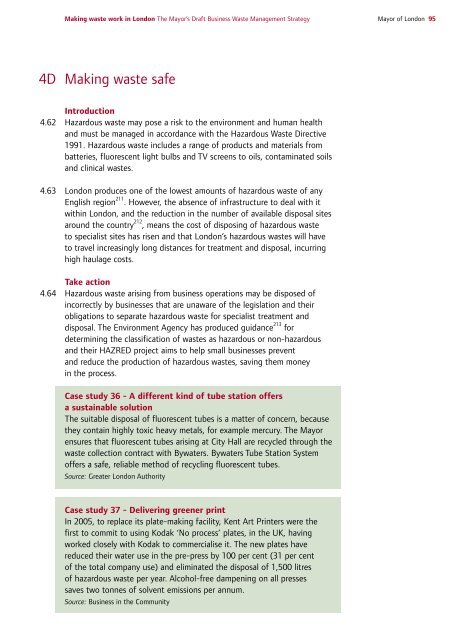Draft Business Waste Strategy PDF - london.gov.uk - Greater ...
Draft Business Waste Strategy PDF - london.gov.uk - Greater ...
Draft Business Waste Strategy PDF - london.gov.uk - Greater ...
You also want an ePaper? Increase the reach of your titles
YUMPU automatically turns print PDFs into web optimized ePapers that Google loves.
Making waste work in London The Mayor’s <strong>Draft</strong> <strong>Business</strong> <strong>Waste</strong> Management <strong>Strategy</strong> Mayor of London 95<br />
4D Making waste safe<br />
Introduction<br />
4.62 Hazardous waste may pose a risk to the environment and human health<br />
and must be managed in accordance with the Hazardous <strong>Waste</strong> Directive<br />
1991. Hazardous waste includes a range of products and materials from<br />
batteries, fluorescent light bulbs and TV screens to oils, contaminated soils<br />
and clinical wastes.<br />
4.63 London produces one of the lowest amounts of hazardous waste of any<br />
English region 211 . However, the absence of infrastructure to deal with it<br />
within London, and the reduction in the number of available disposal sites<br />
around the country 212 , means the cost of disposing of hazardous waste<br />
to specialist sites has risen and that London’s hazardous wastes will have<br />
to travel increasingly long distances for treatment and disposal, incurring<br />
high haulage costs.<br />
Take action<br />
4.64 Hazardous waste arising from business operations may be disposed of<br />
incorrectly by businesses that are unaware of the legislation and their<br />
obligations to separate hazardous waste for specialist treatment and<br />
disposal. The Environment Agency has produced guidance 213 for<br />
determining the classification of wastes as hazardous or non-hazardous<br />
and their HAZRED project aims to help small businesses prevent<br />
and reduce the production of hazardous wastes, saving them money<br />
in the process.<br />
Case study 36 - A different kind of tube station offers<br />
a sustainable solution<br />
The suitable disposal of fluorescent tubes is a matter of concern, because<br />
they contain highly toxic heavy metals, for example mercury. The Mayor<br />
ensures that fluorescent tubes arising at City Hall are recycled through the<br />
waste collection contract with Bywaters. Bywaters Tube Station System<br />
offers a safe, reliable method of recycling fluorescent tubes.<br />
Source: <strong>Greater</strong> London Authority<br />
Case study 37 - Delivering greener print<br />
In 2005, to replace its plate-making facility, Kent Art Printers were the<br />
first to commit to using Kodak ‘No process’ plates, in the UK, having<br />
worked closely with Kodak to commercialise it. The new plates have<br />
reduced their water use in the pre-press by 100 per cent (31 per cent<br />
of the total company use) and eliminated the disposal of 1,500 litres<br />
of hazardous waste per year. Alcohol-free dampening on all presses<br />
saves two tonnes of solvent emissions per annum.<br />
Source: <strong>Business</strong> in the Community
















